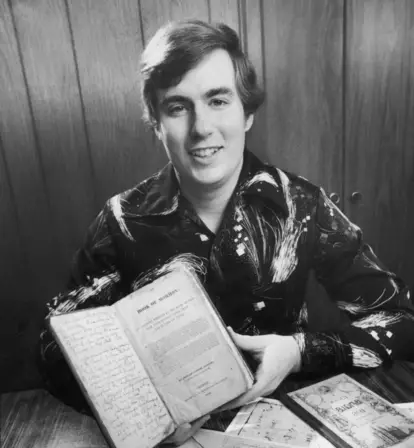Discover the true story of "Murder Among the Mormons," from Mark Hofmann's white salamander letter forgery to his 1985 bombings.
The last of the strange bombs that rocked Salt Lake City over the course of two days exploded on October 16, 1985. Of the three bombings, this one drew the fastest response time.
It went off inside a luxury sports car near the Salt Lake Temple, the largest and most important religious building to followers of the Church of Jesus Christ of Latter-day Saints, more commonly known as the Mormons. By this point, locals were terrified by the bombs. As one resident told Deseret News, “It’s beginning to seem more like Lebanon than Salt Lake City.”
But police soon realized that this was not the work of some “mad bomber” who was killing random people. Shortly after arriving on the scene of the car explosion, authorities noticed that something was different about this bombing. For one, the victim had survived. Critically injured from the explosion, 31-year-old Mark Hofmann was nearly unrecognizable.
Up until then, Hofmann had been a minor celebrity in the Mormon Church thanks to his work as a researcher and document dealer. But within 24 hours, the connections drawn between him and the bomb that had killed a Mormon document collector the day before would expose what kind of man Hofmann really was. It was soon revealed that he had spent years forging his professional legacy — and that he had killed to try to cover it up.
Convicted of second-degree murder and theft by deception in 1987, Mark Hofmann has not left prison in decades. But researchers have never stopped debating both the man and his work. An intelligent yet cunning craftsman, Hofmann created forgeries that were so exceptional that many continue to reside undetected in auction houses and library collections to this day.
What drove an apparently brilliant young man to throw his life away? And why have his forgeries continued to circulate decades after his capture?
The Early Life Of Mark Hofmann

Ben Martin/Getty ImagesMark Hofmann, pictured in Salt Lake City, Utah in 1981. By this point, the young man was already a successful forger.
Born in Salt Lake City, Utah in 1954 to devout Mormon parents, Mark Hofmann had a mostly unremarkable childhood. Although he received poor grades in school, he showed his intelligence in other ways. From an early age, he was attracted to hands-on activities that stimulated his brain.
This took an important turn at age 12, when he decided to take up coin collecting. For most people, this would have been a harmless pastime. But by age 15, Hofmann had found himself deeply interested in the concept of “rarity,” and what exactly made a certain coin valuable.
Hofmann realized that the differences between a valuable coin and a valueless coin could be quite subtle — and that he might be able to reproduce a valuable coin by forging it.
As an experiment, he took an ordinary coin and masked it photographically, leaving only the part of the metal where the mint mark would be. (The mint mark is a letter that identifies where a coin was made.) Then, he electroplated a “D” on the bare spot of the coin and built it up to a certain height to make a new mark — which was rarer than the original one.
Satisfied with his results, Hofmann took his newly forged coin to a local coin dealer. The shop owner examined it and offered him thousands of dollars for the coin if it passed inspection by the U.S. Treasury Department. The 15-year-old did not flinch and told him to send it in.
After his phony coin was authenticated, Hofmann reflected, “If the Treasury Department pronounces it genuine… it is genuine by definition.”
This dubious lesson never left Hofmann, guiding his life to its unusual destination. Along with leading to the deaths of two people, this cornerstone of Hofmann’s philosophy put him both in league and at odds with the LDS Church and the efforts to preserve the legacy of its founder, Joseph Smith.
The Origins Of Modern Mormonism
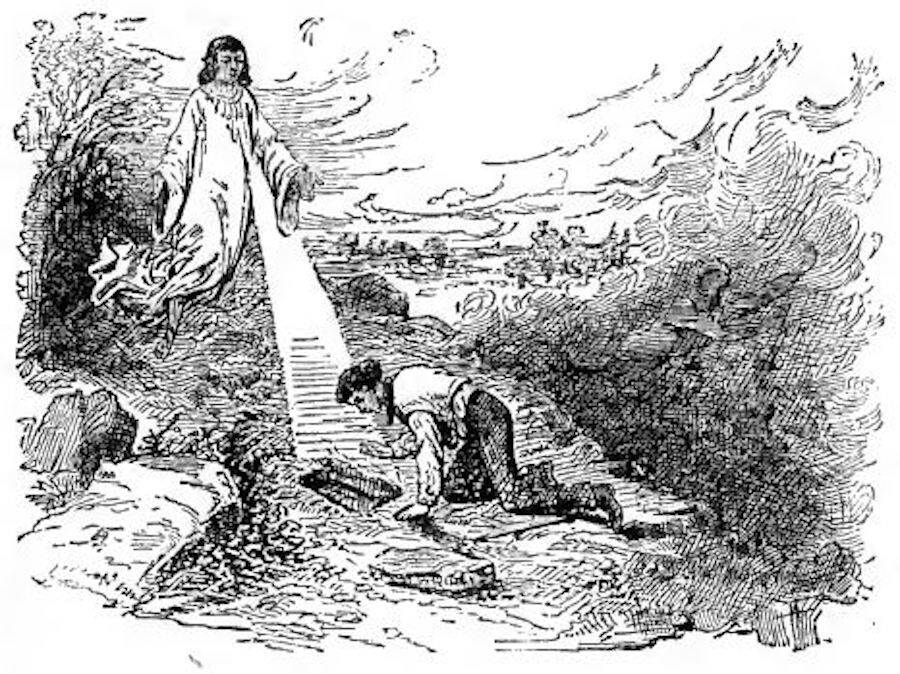
Wikimedia CommonsAn illustration of Joseph Smith being shown the location of the Golden Plates by the Angel Moroni. 1873.
In order to understand what Mark Hofmann was doing, why he was doing it, and how he got away with his crimes for so long, a brief background in Mormon history is necessary.
Originating in the “Burned-Over District” in New York in the early 19th century, the Church of Jesus Christ of Latter-day Saints is unique among American religious movements for its popularity, size, and the debate it prompts over whether or not it is technically a form of Christianity.
According to the traditional LDS story, an angel visited their founder, a poor farmer named Joseph Smith, and told him to dig up a hidden book made of precious metal — often called the “Gold Plates” or the “Golden Plates” — from a hill. The writing in this book was all in an ancient language.
As the LDS story goes, Smith was a prophet of God who was divinely directed to translate the book into what would become the Book of Mormon — a sacred text of the church. It’s worth noting that Mormons also believe that the Christian Bible is the word of God.
However, they do not believe that the current version of the Bible is error-free. They also think that God had more to say after the Bible was completed — hence the Book of Mormon and other important LDS texts like the Doctrine and Covenants and the Pearl of Great Price.

Wikimedia CommonsThe Death of Joseph Smith at Carthage Jail. 1844.
During the 19th century, the promise of direct divine experience and a connection to the biblical past were appealing to many Americans. The religious group quickly began to grow, garnering enemies from the start.
In contemporaneous publications like Mormonism Unvailed? and Time Among The Mormons, a very different image of the church emerged.
According to them, Joseph Smith was not a prophet or a martyr (he was murdered by an anti-Mormon mob in 1844), but a power-crazed con man who used manipulation and magic to create a polygamous cult that he intended to turn into a kingdom within — or in place of — the United States.
While the historical truth about Joseph Smith is likely somewhere between these extremes, it is unclear what Mark Hofmann thought of the religion’s founder before he left for England in 1973.
The Last Temptation Of Mark Hofmann

Wikimedia CommonsIn 1834, Mormons found the bones of “Zelph” — who Smith said was an ancient “Lamanite” American — at Naples-Russel Mound 8 in Illinois. The mound is now recognized as a burial site of Native Americans of the Hopewell Culture.
A two-year period of overseas missionary work is common for young Mormon men. And so when he was 19 years old, Mark Hofmann’s mission took him to Bristol, England.
While there, whenever he wasn’t doing official work, he was looking for old books about Mormonism. He seemed especially interested in critical texts, such as No Man Knows My History by Fawn Brodie, a skeptical biography about Smith that treats the Mormons’ founding prophet as a charlatan.
In these books, Hofmann was likely to encounter embarrassing stories like the skeleton that Mormons dug up from a mysterious burial mound in Illinois in 1834. As the story goes, Smith named the skeleton “Zelph” and composed an elaborate history for the ancient “Lamanite” American.
Today, it’s now known that the mound is actually a burial site of Native Americans of the Hopewell Culture — and had nothing to do with the ancient peoples described by Smith. Hofmann probably wouldn’t have learned this story when he was younger.
Chances are, this was also around the same time when Hofmann first encountered a disturbing theory about the origins of the Book of Mormon — which he would eventually attempt to support through his forgeries.
For some Mormon believers, the best evidence for the Book of Mormon’s authenticity as scripture — the word of God presented by the angel Moroni and translated by Smith — is the fact it is too long and complex for the uneducated Smith to have come up with himself.
The “Spalding-Rigdon Theory” also accepts that basic premise — but for a far darker reason. Proponents of this theory suggest that Smith’s friend and early follower Sidney Rigdon stole an unpublished novel, which was about lost mound-building civilizations. This book was said to have been written by a deceased writer named Solomon Spalding. And Rigdon and Smith allegedly decided to pass it off as scripture.
Most LDS members make a choice about Mormonism once they encounter these stories and theories. If they believe the Book of Mormon is real and that Joseph Smith is a prophet, then they discount the accusations and either try to refute them or never read them again.
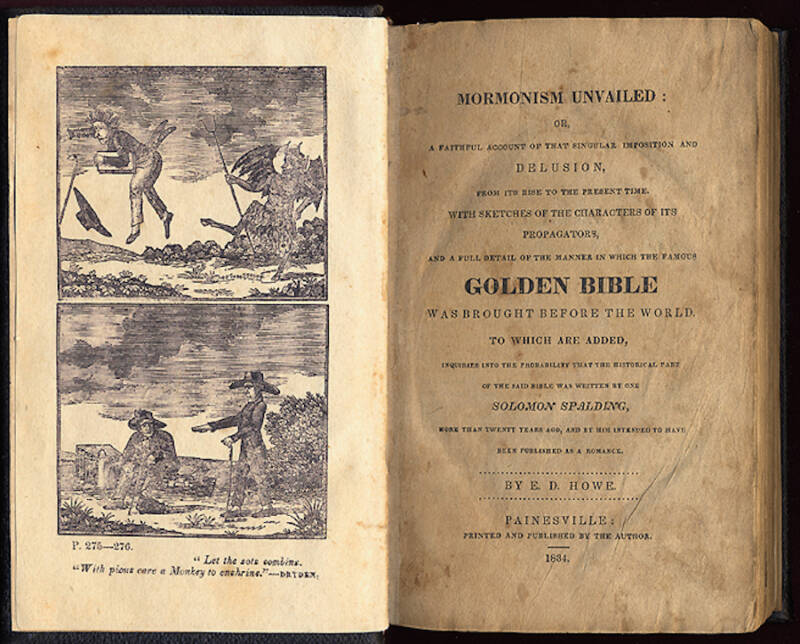
Wikimedia CommonsMormonism Unvailed was one of many anti-Mormon publications that came out during the 19th century.
But if they think the accusations are true, then they probably believe that Joseph Smith was a liar and that Mormonism was started as a con. This conclusion may contribute to an estimated 36 percent of Americans born into the Mormon Church leaving it as adults (though that number is lower than adults leaving the Catholic Church, according to the same study).
Hofmann had a very distinct reaction upon discovering these assertions.
He had already lost his faith around the age of 14. At some point, he had also discovered that his grandfather had practiced polygamy — which made him angry. So Hofmann’s continued participation in the church was largely out of social pressure, not personal interest. In England, this clearly changed as he became deeply interested in material that was skeptical of Mormonism.
The question of Smith’s sincerity did not seem to bother Hofmann. If anything, replacing the church’s idealized portrait of the prophet with a crafty, young huckster probably made the Mormon founder more relatable.
Instead, Hofmann’s feelings hardened against the church itself — and the people whom he felt parroted the religion and covered up any unsavory aspects of the church’s origins. That, at least, was the reason he eventually gave for targeting the LDS Church and its leadership with his crimes.
The First Major Forgery: The Anthon Transcript
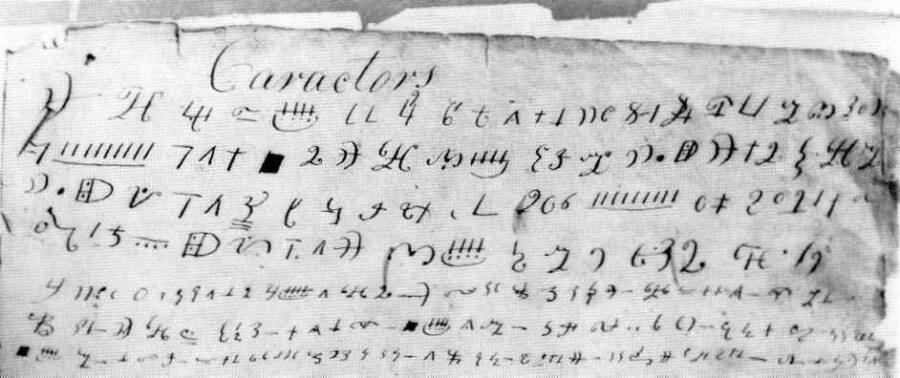
Wikimedia CommonsThe “Caractors” Document, a copy of the original Anthon Transcript that has been preserved since the 19th century.
Mark Hofmann returned to Utah in 1975 and later enrolled in college as a pre-med student, but he found himself unable to maintain a facade of normalcy. An unsent letter that he wrote to his mother captured some of the concerns occupying the young man’s mind:
“Dear Mom,
During our Easter feast you gave it as your opinion that certain materials in the church archives should not be made public because there exists certain faith-demoting facts that should not be known. While you may take comfort in knowing that this has been an attitude of the leadership of the Church, you have expressed anxiety because I do not share this belief.”
After marrying Doralee Olds in 1979, Hofmann turned his attention to committing his first major crime. It’s uncertain whether he wanted to start tormenting the Mormon Church right away or if he was simply concerned about his finances. Either way, he knew there was money to be made.
In April of 1980, Doralee returned home to find her husband looking at a 1688 King James Bible he had bought in England years ago. He said that some of the pages were stuck together, and she watched as he pulled them apart.
Inside, a folded sheet of paper was stuck to the pages with a layer of hard, rubbery glue. The adhesive prevented the couple from examining the paper fully, but from what Doralee could tell, one of the things written on it was a signature that looked a lot like Joseph Smith’s.
The next day, with his wife’s encouragement, Hofmann took the book to Utah State University, where researchers quickly became astonished by the contents of the miraculous manuscript inside. They believed they were looking at the original Anthon Transcript — an incredible find.
Back in 1828, Charles Anthon, a classical scholar and linguist at Columbia College (now Columbia University), was approached by an early Mormon convert named Martin Harris. Anthon was asked to identify some strange characters that Smith had translated from the Golden Plates. Though it is certain that this meeting took place, its results have been disputed for years.
According to Harris, Anthon pronounced them “true characters” and said the translation was correct. He also offered a letter of authentication, but allegedly tore it up once he heard about the involvement of angels. Anthon also demanded to see the plates so that he could translate them as well. But when he learned that the plates were partially sealed, Anthon said he could not read a “sealed book.”
However, other sources claim that Anthon never believed the characters were genuine. Instead, he allegedly called the whole thing a hoax from the start and informed Harris that he was being deceived.
The original document that Harris presented to Anthon is lost, but a copy called the “Caractors” Document is preserved by the Community of Christ, a smaller denomination of the Latter Day Saint movement. If the original document of the Anthon Transcript were ever found, it would be considered priceless to the Mormon Church.
That’s why Utah State researchers were so excited in April of 1980 when they unfolded the secret document from Mark Hofmann’s old book. In hindsight, even more remarkable than the forgery itself was Hofmann’s ability to keep a straight face. He later revealed that he got his recipe for the ink from a book he stole from that very same library. And the paper that he used may have been stolen from an old book there as well.
The hoax was impressive on a number of levels: In addition to the period-appropriate paper and ink, Hofmann had successfully reproduced Joseph Smith’s poor handwriting and spelling, apparently paying close attention to the original examples held in the Utah archives.
Similarly, assuming the “Caractors” Document copy was partially correct, Hofmann had carefully modified it and added a few features to match the description Anthon had given of what he had been shown, including a “Mexican calendar” that Hofmann created by tracing a beer bottle.
Artificially aged with either ammonia or hydrogen peroxide, it was an excellent product of research and craftsmanship. The LDS Church paid Hofmann more than $20,000 for the document.
Learning All The Wrong Lessons

Wikimedia CommonsHofmann’s forged Anthon Transcript, sold to the LDS Church for more than $20,000.
Following the sale and the publicity for having made such an important “discovery,” Mark Hofmann dropped out of college and decided to make a full-time career out of forging rare documents. Returning to his interest in currency, he also began forging some antique Mormon money based on the detailed descriptions found in the church archives.
While high prices were not unusual in certain segments of the rare books and manuscripts markets, the frequency with which Hofmann was able to make sales came down to two important factors.
First, the LDS Church was engaged in a spending spree, building temples and archives all around the world, and they had no problem plunking down more money for valuable documents.
Second, Hofmann understood his targets and their motivations on a personal level, and kept them supplied with tailor-made material that catered to both their desires and their fears.
Between 1980 and his capture in 1985, Hofmann made and sold hundreds of forged documents, but his biggest customer was the LDS Church. During this single period, he sold them lost proclamations by Joseph Smith, letters written by the prophet’s mother, pages from the original manuscript of the Book of Mormon, and valuable signatures of prominent Mormons.
When he wasn’t selling forgeries of Mormon-related material, he was writing in the hand of Emily Dickinson, Mark Twain, Abraham Lincoln, and more.
While at first, it seems understandable that an institution would continue to return to the same supplier, the sheer number of impossibly important discoveries Hofmann produced begs the question of why he wasn’t caught sooner. No individual can find the Holy Grail more than once in a matter of just a few years without raising some questions.
For all the focus on the fine details of forgery — inks, papers, chemical treatments — selling a forgery has little to do with the object itself. It has more to do with the feelings it provokes, and how the seller can use that to manipulate a victim into not seriously examining what they are buying.
In the case of the Anthon Transcript, Hofmann’s hunch was that the LDS Church would not test the document too strenuously for fear of damaging it. Having established a relationship and credentials, he continued to sell to many different church officials. And over time, Hofmann’s positive reputation kept buyers from scrutinizing his claims too closely.
Even if they are tempted to scrutinize, forgery victims often experience a form of the “sunk cost fallacy,” where they continue to go through with the purchase due to the time or money they’ve already invested. And for his dealings with LDS leadership, Hofmann also had one very compelling psychological sales tactic that he would employ for his Mormon material.
Blackmail By Any Other Name

Wikimedia CommonsThe LDS Church Administration Building in Salt Lake City, Utah. 2009.
Something Hofmann and the LDS Church had in common was unhappiness with certain past events. For Mark Hofmann, it had been his grandfather’s polygamy and subsequent excommunication. For the church, it was a variety of controversies that were woven into its history and founding.
In most older religions, history has not provided us with that many specific insights into the contexts of their origins or the personal lives of their founders. For example, we do not know what Prince Siddhartha Gautama’s subjects thought or said about him when he left his life as a ruler’s son behind to become the Buddha.
On the other hand, when it comes to the LDS Church and Joseph Smith, we have access to a lot of archival material that details what has been said by or about both the man and his church since the early 19th century. And there’s quite a bit of information that could serve as a source for scandal.
Whether it was the practice of polygamy by Smith (who married at least one girl who was younger than 15), the creation of a private army called “the Nauvoo Legion,” the accusations of “money-digging” and magic from Smith’s youth, the Mormon rituals borrowed from Freemasonry, or the problematic view of Native Americans put forth by early Mormons, there were many topics that the church was tired of talking about by 1980.
Just two years prior, they had allowed Black men into the priesthood for the first time after announcing that they had received a “revelation” that it was time for the prohibition to be lifted.
But as the church continued to expand, it became more conscious of managing its public image, and these unsavory historical details took on a new significance for both the LDS leadership and Mark Hofmann.
While some of Hofmann’s “discoveries” related to Mormonism were positive, many other documents were considered to be damaging to Joseph Smith or the church’s reputation.
By buying these incriminating items, the LDS Church likely thought that they were quieting any more potential scandals. Of course, the manuscripts themselves were forgeries. But with the church seemingly attempting to suppress them, Hofmann believed that the LDS leaders were confirming that the accusations they contained were actually true.
The Salamander Letter: The Most Scandalous Document In Mormon History
First sold to Steven Christensen, a Mormon bishop and document collector (whom Hofmann would later kill with a bomb in 1985), the “salamander letter” purports to be written by Martin Harris. The letter was allegedly written in 1830, and it tells a very unusual version of the story of how the Golden Plates were discovered.
Unlike the LDS Church’s official version, where a young farmer is visited by an angel, the salamander letter describes a treasure hunter apparently using magic to summon an amphibian.
Free of any punctuation, the document describes Harris’ first meeting with the man whom he would later follow as a prophet. In the letter, Harris states that he was introduced to Smith by his father, who said, “Joseph can see anything he wishes by looking at a stone Joseph often sees Spirits here with great kettles of coin money.”
He then goes on to retell how he first learned of the discovery of the Golden Plates. Instead of being shown the Golden Plates by an angel, Smith allegedly found them with the help of just a stone and a spirit that transfigured into a white salamander.
Eerily, the spirit also demanded that Smith should bring his recently deceased brother if he wanted to get his hands on the “gold bible.”
The rest of the letter is a brief, blasé chronology of Harris’ trip to visit Professor Anthon and seeing the Golden Plates in June of 1829.
Strange as this document’s contents are, it’s stranger to consider that, after reading it, Christensen purchased the letter from Hofmann. Why would a respected church member believe in the authenticity of a document that claimed Smith received the church’s sacred text from a salamander?
The truth is… complicated.
The Real Joseph Smith: Was He A Sorcerer?

Wikimedia CommonsImage of Joseph Smith receiving the Golden Plates and the magical “Urim” and “Thummim” glasses from the Angel Moroni. From Reminiscences of Joseph, the Prophet. 1893.
There are some uncomfortable details about the life of Joseph Smith that make the salamander letter’s story at least somewhat plausible.
In his youth, Smith was known for his ability to supposedly locate valuables by looking at a “seer stone.” This practice, technically called “scrying,” is also found in the story of the biblical Joseph (who used a silver cup), but it is more commonly recognized in the occult and esoteric traditions.
Staring at a fixed surface will often prompt the brain to start searching for patterns, causing visual distortions that scrying practitioners interpret as premonitions and messages. This practice continues into the modern day with more well-known tactics like looking into a crystal ball.
The LDS Church acknowledges Smith’s work as a “money digger,” claiming he abandoned it after recovering the Golden Plates in 1827. However, New York’s records show that Smith was arrested in 1830 as a “glass looker.”
Continuing in this vein, the translation of the Golden Plates is worth reconsidering. While some modern depictions show Smith reading directly from the plates, the “translation” may have been less hands-on.
According to some surviving accounts, the Golden Plates may have actually been hidden from view by a curtain, as Smith read the translated characters off of a stone inside a hat. A similar practice of blacking out vision with a small enclosure to scry crystals has been documented elsewhere, with reports of parallel practices continuing at least into the 20th century.
Smith’s personal use of scrying in the receipt and translation of the Golden Plates would be enough to argue for a strong connection between the two, but his use of stones for revelations in additional documents like the Doctrine and Covenants makes the argument even stronger. He was also known to have used a variety of stones throughout his life.
There are also other Smith family items, held in private collections and out of public view, which reinforce the connection between the Mormon prophet and magical practice. The first is a knife owned by Joseph Smith Sr. and given to his son Hyrum. This knife has a carving on the blade with the astrological symbols for the planet of Mars.
According to The Magus, these symbols “engraven on an iron plate, or sword, makes a man potent in war and judgment, and petitions, and terrible to his enemies, and victorious over them.”
The second is a talisman found on Joseph Smith Jr.’s person after he was murdered, bearing the symbols for Jupiter, which promise that the wearer will “gain riches and favour, love, peace, and concord, and to appease enemies, and to confirm honours, dignities, and counsels.”
Additionally, Smith’s not-so-subtle borrowing of certain Masonic rituals for Mormonism, his alleged marriage to the widow of William Morgan (presumed to be murdered for revealing Masonic secrets), and his use of a Masonic distress call before he was killed are also worth consideration.
Given the evidence, it is fairly easy to make a case — even without getting into the more esoteric aspects of Mormon theology — that Smith had a lifelong interest in magic.
In fact, the very accusations Hofmann had couched in the salamander letter had existed since at least 1833. One of Smith’s neighbors claimed that when Smith was digging for the gold plates, he found a box that contained the book and “something like a toad, which soon assumed the appearance of a man, and struck him on the side of his head.”
Mark Hofmann’s Big Slip-Up
Though there were some factors that made Mark Hofmann’s salamander letter believable, it was met with far more skepticism than his Anthon Transcript. And even though Steven Christensen had purchased it for $40,000, he still intended to have it checked out further to validate it.
Despite the tentative declaration of authenticity by some local experts, overall scholarly opinions were split. For some, it was the proof they had been searching for their entire careers about the real Joseph Smith. For others, the letter just seemed both too radical and too convenient.
It was the frustration felt by local Utah researchers Jerald and Sandra Tanner that helped lead to Hofmann’s downfall. The Tanners had researched occult and magical influences on early Mormonism before and were aware of the connection, but something about the salamander letter didn’t feel right.
Although the handwriting, paper, and ink were correct, something was wrong with the language. Martin Harris was a devoutly religious man. A genuine letter from him mentions “Lord,” “Angel,” and “holy” multiple times. It also makes room for other religious terms.
But the salamander letter, which was allegedly from the same man, was completely devoid of religious language. This was especially unusual since the content of the letter focused so heavily on the origin of his religion, not to mention his interactions with an actual prophet.
On top of that, this letter was significantly longer than the genuine letter, which was clearly full of religious words and phrases.
It was a subtle but irrefutable discrepancy. Hofmann had slipped up.
Mark Hofmann’s Deceptions Begin To Crumble
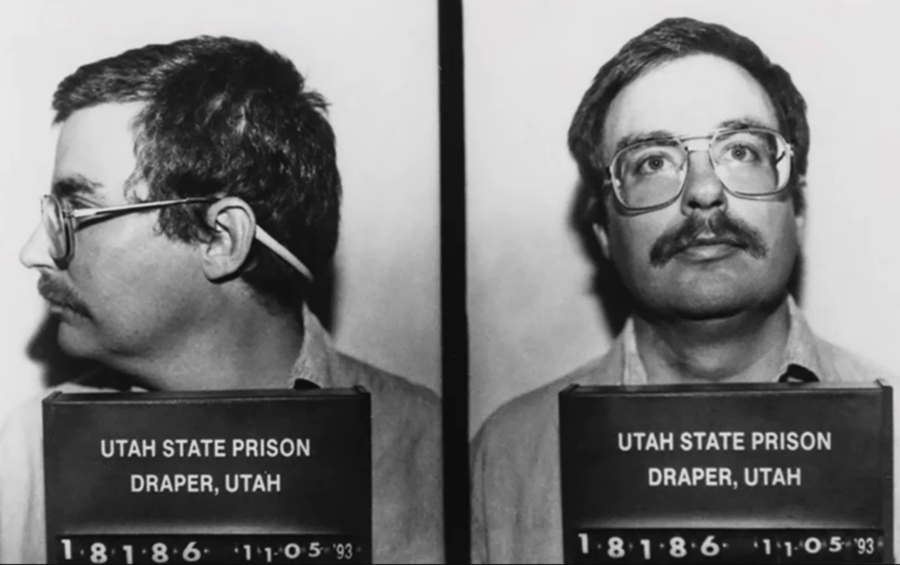
Public DomainOne of Mark Hofmann’s earliest mugshots. After serving 28 years at Utah State Prison in Draper, he was moved to the state prison in Gunnison in 2016.
Shortly before the bombings began, Mark Hofmann was involved in the two biggest deals of his career. Both were based on lies that would ultimately lead to nothing, but Hofmann’s reaction to their collapse took him to a far darker place than he’d ever gone before. His decision to kill in order to cover up his forgeries is why he will never see the outside of a prison cell again.
First off, Hofmann claimed to have found the “Oath of a Freeman” — an oath sworn by early Massachusetts Bay Company members in the 1630s. It was thought to have been the first printed work in the United States. And it had long been lost, known only through reproductions.
Hofmann claimed that he found this precious document in the Argosy Book Store in New York City, and that it dated back to 1638. In reality, of course, he had slipped the forgery into the bookshop himself.
After he pretended to find it, he purchased his own phony creation at the front desk for $25 in order to create a paper trail. Then, Hofmann started boasting about its value, claiming that it was worth $1.5 million.
Not long afterward, while he was negotiating for an auction or a possible sale to the Library of Congress, Hofmann pushed his luck by claiming to have found a second copy of the Oath.
That would have been odd under any circumstances. But the idea that one man could find the Anthon Transcript, the salamander letter, and two copies of the long-lost Oath on top of all of his other discoveries stretched credulity. To a growing number of people, this just didn’t seem possible.
But mounting suspicion did not matter. Hofmann could no longer stop. His personal collection of real rare books, the home for his family, and the expensive sports car he had bought for himself, among other expenses, had left him in desperate need of money. Now, with all the loans he’d taken and promises he’d made, he was already on borrowed time.
Mark Hofmann was as good as caught. It was just a matter of when.
At some point around this time, Hofmann began to indicate to various members of church leadership that he had located the “McLellin Collection,” a group of manuscripts and papers belonging to William E. McLellin, an early Mormon leader that was excommunicated from the church.
Due to McLellin’s status and connections to the church’s founders, it was believed that whatever he had written in his journals or taken with him into exile could be incredibly damaging to the church. Or at least, this is what Hofmann wanted the church to believe.
The evidence suggested, as one officer concluded, “There was no McLellin Collection.” (It was later revealed that this collection actually was real, but it had nothing to do with whatever Hofmann was planning to forge.)
Meanwhile, Hofmann was still securing loans from different members of church leadership, always delaying the delivery of the collection. He gave countless excuses as to why he needed more money. After taking yet another loan for $185,000 — his total debt would eventually reach over $1 million — Hofmann still didn’t show the collection to any potential buyers.
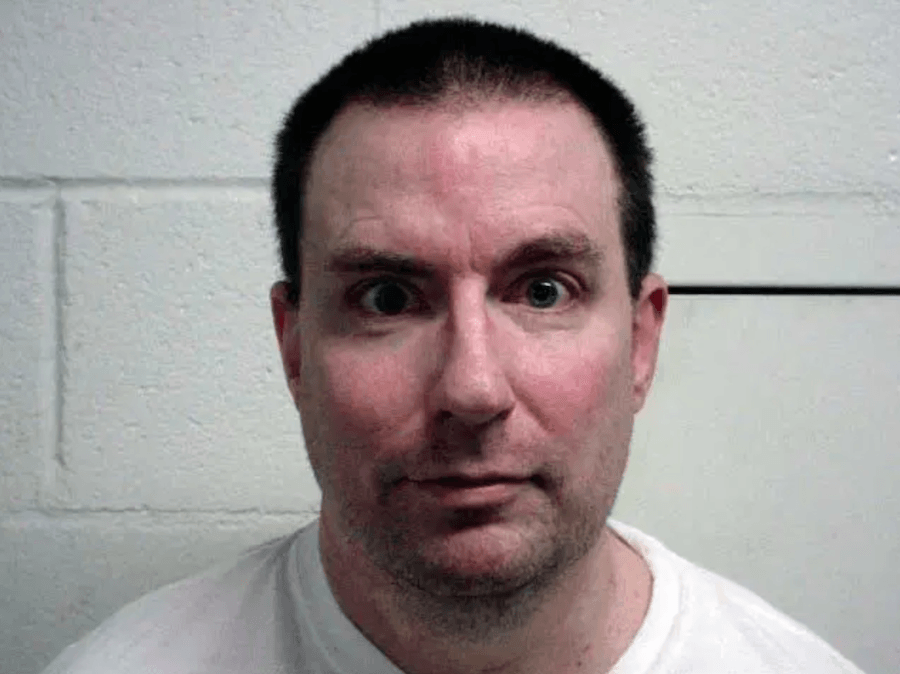
Utah Department of CorrectionsA more recent picture of Mark Hofmann, taken in 2010. Ever since he got to prison, he has avoided the spotlight and refused to do interviews about his life and crimes.
In the fall of 1985, Christensen grew increasingly concerned about Hofmann’s honesty. He also began to press Hofmann to pay his loan back as soon as he possibly could. It was only in early October that he learned that Hofmann’s Library of Congress deal had fallen through.
On October 11, Hofmann was supposed to meet Christensen to endorse the McLellin Collection so that they could make a deal with a Mormon investor. But Hofmann never showed up. Christensen angrily asked a friend to tell Hofmann that he was at risk of criminal charges — as well as excommunication from the church.
Instead of taking the fall for fraud and theft, Hofmann sealed his fate with life in prison for a reckless and unnecessary double murder.
From Forging Letters To Building Bombs
The first of Mark Hofmann’s three pipe bombs killed Christensen in his office in Salt Lake City on October 15. Hofmann’s decision to drop off the bomb wearing his letterman’s jacket was one of the key pieces of evidence used against him in court — as witnesses had recognized the jacket.
The second bomb went off that same day at a local home, killing Kathy Sheets. She was the wife of Hofmann’s intended target, Gary Sheets, who was Christensen’s business partner. He was also linked to the McLellin purchase and the authentication of the salamander letter.
The third and final bomb nearly killed Hofmann himself, as it went off accidentally in his car the next day.
He later suggested that this was a suicide attempt, but it’s believed that he had likely meant to use the bomb on someone else. It’s possible that the autograph dealer Brent Ashworth or even the Tanners — who had been writing articles questioning the authenticity of the salamander letter — might have been Hofmann’s next victims. But instead, Hofmann dropped the third bomb in his car and tried to catch it, causing it to explode.
The prosecution had an open and shut case. Hofmann’s dealings with Christensen, evidence of a massive forgery operation in his basement, and the discovery of an alias he had used to purchase forging and bomb-making materials were only a few pieces of proof of his guilt that had emerged.
And in Hofmann’s destroyed car, authorities found a section of a galvanized pipe — which looked very similar to the pipe used in the previous bombings.

Wikimedia CommonsTemple Square, not far from the site of Mark Hofmann’s final explosion.
In 1987, Hofmann pleaded guilty to two counts of second-degree murder and theft by deception. He was then sentenced to life in prison. Shortly into his sentence, his wife — who claimed she had been oblivious to the crimes comitted in their basement — divorced him, sending Hofmann into a spiral.
He attempted suicide via a drug overdose and collapsed in his cell. Although he was later revived, he had spent a long time lying on the floor, suffering severe tissue damage to his right arm.
Sorting Through The Rubble
Mark Hofmann has not forged anything in decades, yet his impact is still felt at auction houses, libraries, museums, and private collections around the world. He may have been caught and locked up, but his work lives on.
The mix of research and technique he utilized was so skillful that about a decade after his capture, an Emily Dickinson forgery of his was authenticated by R.W. Franklin, the director of Yale University’s Beinecke Rare Book & Manuscript Library. It was eventually sold for $24,150 through Sotheby’s.
“It’s an extraordinarily good forgery,” said Selby Kiffer, the senior vice president at Sotheby’s. “The correct paper for the period, the correct writing instrument for the period, the literary tone was quite good — and the imitation of the writing.”
While many auction houses have sold Hofmann’s work by accident, evidence suggests some institutions may be purposely leaving Hofmann’s name out of descriptions of item provenance. As one auction house representative explained, “We don’t guarantee it to be authentic. We guarantee it. We sell it, and if the customer does not like it, we’ll give them their money back.”
In all, the LDS Church identified 446 items in its archives as fraudulent purchases that had come from Hofmann. These were subsequently removed, along with all positive mention of Hofmann and his discoveries previously featured in church magazines and literature.
Today, images of Hofmann’s creations still adorn some of the digitized covers of old issues, but the articles explaining the items have been removed from the record. As a single example of a recurring problem, Hofmann’s case raises several uncomfortable questions.
How many pieces in archives today are the creations of Hofmann and others like him that have gone unexamined? What aspects of our history have been altered or added by clever forgers? Or worse, what actual historical items and their contents have been removed from the record and incorrectly written off for having passed through someone like Hofmann?
These are questions worth considering during any time period, but one with especially interesting implications for the 21st century. In a time when anyone can sell just about anything on eBay, experts say it’s only a matter of time before the next Hofmann strikes, if he or she has not struck already.
After learning about Mark Hofmann’s life of crime, examine more mysteries of Mormonism by taking a look at their so-called “magic underwear.” Then, read about Lee Israel, the biographer-turned-forger whose concern for her sick cat led to a life of crime.
